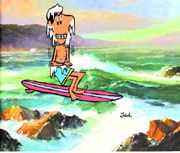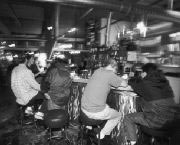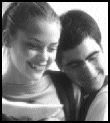THE UNEASY FEELING SETS IN just about the time you’re strapping that Tom Scott 8′-6″ onto the roof rack of your scruffy-looking Subaru. You’re in Ballard. It’s cold. It’s wet. It’s winter. You’re just on the wrong side of 5am.
Your bleary-eyed neighbor—who has no business being up at this hour anyway—looks at you, looks at the board that’s fastened to the top of your car with architectural precision, looks at you again, and wordlessly lets on that he doesn’t have any idea what the hell you’re doing. Clearly, you’re the kid who doesn’t belong here. But, whatever—he’s back inside with his plastic-bagged P-I and you’re left to your own ill-advised plans.
People in Seattle surf. Who knew? Surfing is sketchy, sun-baked, 1960s California. It’s about attitude, surf shacks, dustups with the locals, and a borderline criminal subculture that’s committed to a mystic and proudly irresponsible quest. Surfing is Jack London, Henry Miller, and (depending on who you talk to) Tom Wolfe. Forget about Gidget, Tab Hunter, and even the Ventures. If you want to pick a sport that’s antithetical to Seattle’s collective myth, surfing would likely top the list. Surfing is cowabunga. For those who haven’t noticed, Seattle is decidedly not cowabunga.
But people here do surf, and most of them get in their sessions just a couple hours away, snugly tucked into their superhero wet suits to weather the 40- to 60-degree waters near the small coast town of Westport. If you’ve never been to Westport (which is likely), you’ll find the economically depressed burg at the end of the line, 20 miles out from Aberdeen where Highway 105 veers south to avoid dead-ending into the chilly Pacific. Its anchor position on the Greyhound bus line ensures the otherwise amiable, 2,000-plus town a robust influx of the Western states’ freaks and ne’er-do-wells—amusing if you’re visiting, maybe, but often a pain in the ass for locals.
Surfers from Seattle—and as far away as Vancouver, BC, and Plains, Montana—congregate regularly in a few choice spots alongside Westport’s sandy break: the Cove, the Jetty (courtesy of a ’40s-era Corps of Engineers project), and the Groins, the last located just behind the well-worn and well-loved Islander, a bar catering to the out-of-work working-class where you can frequently check out blues bands “straight from Seattle.” (Of course, when it comes to the blues, nearby Aberdeen’s a safer bet than our own city.com. Just ask Nirvana.)
With a reasonably reliable four- to six-foot swell in the summer, Westport qualifies as an exceptional beginner’s break, perfect for most Seattleites—especially the REI-lovin’ gearheads who seem just as happy e-mailing their friends about their purchases as they do actually surfing. And thanks to the Pacific’s potent winter storms, surfers willing to brave rain, snow, and ice can take on waves double that height at a time when many Westport locals check out to snowboard.
To nonsurfers, this whole arrangement may border on the uninteresting—yet another “extreme” sport for well-paid Seattle Web developers/account execs/graphic designers/copy writers/ jackasses to go out and blow their money on, ࠬa rock climbing, mountain biking, snowboarding, et al. Here’s your board, your wet suit, your booties, your hood, your gloves, your board bag, your rash guard, your rack, blah, blah, blah. Congratulations. We’ll watch for you on ESPN2.
But to surfers, the evolution of Washington’s surf community is symptomatic of a cancer that’s slowly eating at the sport’s spiritual core. Even to use the designation “sport” is taking a liberty: You’ll often hear surfing earnestly described as a path—and not just by spliff-smoking hippies who talk about making love to the waves.
Understand that Westport is conceded territory. It’s the West Bank, compromised, beyond reasonable recovery. When Surfer magazine first spilled the beans about Westport back in the ’80s, everyone freaked out, but no one seriously cares anymore. Sure, there are a few half-hearted locals in town, all bleached goatees and attitude, but they’re strictly junior varsity compared to the hatchet-wielding hardcores down in Seaside, Oregon, or the shotgun-toting Indians you’ll find guarding Washington’s more sacred surf spots. The action rarely gets close and vocal in Westport—only the most flagrant drop-in will earn you the chance of the beatdown that your Kirkland ass probably richly deserves.
WESTPORT ATTRACTS a peculiarly Seattle-style surfer, not so much polite as subdued. These are neoprened men and women who likely surfed the Web before they ever surfed the waves. This strange creature, almost unrecognizable to its evolutionary predecessors, lurks on alt.surfer, obsesses over meteorological minutiae, and divines the North Pacific’s mysterioso swells through decidedly non-mysterioso means: the Weather Channel, NOAA buoy reports on the Web, and orthographic global significant wave height maps, online courtesy of our own US Navy. Webcams broadcasting real-time surf conditions have already gone up all along the West Coast, and Westport is next (www.westportcam.com).
Locals in Westport still occasionally paddle out to disable the NOAA buoys, risking federal prosecution, but the battle is lost. Technology always wins (Seattle has taught us that lesson if nothing else). The real casualty of such post-modern surfing, connecting with the ocean by remote and tenaciously hanging onto that day job, is hard to quantify. It’s a disconnection that’s incongruous with surfing’s traditional ideals. Doc Renneker, an Ocean Beach legend, once observed, “Making a place yours—that’s a lot of what surfing is about.” One longtime local surfer talks about tending one of his favorite spots (don’t, of course, ask where). He makes the long drive out often, even on shitty days, to watch the waves break and just be there; there’s a lot to learn about the topography, the tides, the current, the size and quality of what rolls in. And there’s nothing, absolutely nothing, worse than being at a place that’s assuredly yours on a perfect day and then having some yahoo from Kent or Queen Anne blow in and say, “Hey, this place is great!” surf a couple nice sets, get in your way more than once, and then pack it up and head home. Suddenly the whole hatchet-and-shotgun approach starts to make sense.
But whether Seattle surfers have earned their right to the dives and swallows on the coast remains to be seen—even for those who’ve committed themselves year after year to surfing’s slow learning curve and Washington’s frigid waters. Solid waves keep rolling in regularly at non-Westport spots like La Push and Point Grenville (just south of Taholah on the Quinault reservation), and nonlocals continue sussing out these not-so-secret swells. But do they deserve it? Do they deserve anything more than that quick, late-evening ride in the shadow of the Islander?
For all their lack of beach cred, Seattle surfers put up with a lot. Trips to Cheka-Looka on Eastlake and long drinks while watching surf videos at First Ave’s Ohana frequently have to substitute for the real thing. And, frankly, once you’re out in the lineup, where you’re from doesn’t really matter: If you put in your time, if you follow the rules, if you’re not an ass, then you can get along just fine. Even if you’re from Ballard.
Surfing’s always been a demanding, potentially life-consuming spiritual search, ever since Duke Kahanamoku made his balletic half-mile ride in on a Himalayan wave off Waikiki in 1917. Seattle surfers might stray from that quest, insisting on niceties like jobs and relationships, but sometimes they get it right, even—or perhaps especially—when that most precious of rides can only be caught at low tide, chasing the wake coming off the Bainbridge Island ferry.








